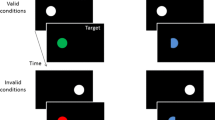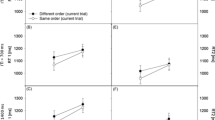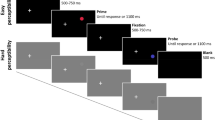Abstract
We investigated the attention-shift hypothesis of the Simon effect by analysing the effect of repeating relevant colour or irrelevant location of the stimulus in four serial reaction time tasks. In Experiment 1 with short response-stimulus intervals (RSI), we assume that there is no time to engage attention at the fixation cross before the onset of a new stimulus. In agreement with the hypothesis, Experiment 1 reveals no Simon effect when the stimulus location is repeated. In Experiment 2 with long RSI, we observe a Simon effect for location repetitions and alternations. In Experiment 3 with long RSI, we hinder the disengagement of attention by displaying the stimulus after response execution. As expected, the Simon effect is reduced for location repetitions. In Experiment 4 with stimuli additionally presented at the fixation cross, responses are faster if the attention shift towards the centrally presented stimulus corresponds with the location of the required response. Additionally, we argue that binding of the stimulus features into an object or event file better explains the so-called blocking of the automatic response-priming route after a noncorresponding trial.
Similar content being viewed by others
Author information
Authors and Affiliations
Additional information
Received: 2 February 2000 / Accepted: 10 November 2000
Rights and permissions
About this article
Cite this article
Notebaert, W., Soetens, E. & Melis, A. Sequential analysis of a Simon task – evidence for an attention-shift account. Psychological Research Psychologische Forschung 65, 170–184 (2001). https://doi.org/10.1007/s004260000054
Issue Date:
DOI: https://doi.org/10.1007/s004260000054




